Part 3 - The Heart of Tuscany
It took us about 3 hours from Lucca to Siena by a pleasant and scenic train ride. We rented a car in Siena and drove another hour to our next destination - Agriturismo La Grencaia in the heart of Tuscany. Agriturismos are simply the best way to experience rural Tuscany: rustic, rural accommodations, very reasonably priced, run by families who are dedicated to making sure their guest are well-fed. Our agriturismo was run by a friendly Franco and Carla, both teachers, who bought this place while it was a ruin and completely restored it.
It's a beautiful place.Cesta vlakem z Lucca do Siena trvala asi 3 hodiny příjemnou a malebnou jízdou. V Siena jsme si pronajali auto a vyrazili do naší další destinace - Agriturismo La Grencaia v srdci Toskánska. Agriturismos (farmy s ubytováním) nabízejí bezesporu nejlepší ubytování: rustikální, venkovské ubytování, velmi cenově dostupné, provozované místními obyvateli, jejichž jedinou starostí je, aby se hosté cítili jako doma a byli dobře živeni. Našimi hostiteli byli dva učitelé Franco a Carla, kteří farmu koupili v dezolátním stavu a kompletně ji zrenovovali. Opravdu nádherné místo!

DAY 1
After a hearty breakfast prepared by our wonderful hosts, we decided to do a Heart of
Tuscany Drive through velvety, gentle, rolling hills, visiting a fortress, a
few towns and a farm tour on the way.
Imagine vibrant green fields, rolling to infinity, punctuated by snaking cypress-lined driveways, humble but beautiful hill towns, abbeys, countryside restaurants and much more.
La Dolce Vita.
První Den
Toskánsko je kraj proslulý uměním, historií, působivou scenérií a také významnou produkcí vína. Města často obklopují etruské hradby a hojně rozšířená vegetace cypřišů.
Po vydatné snídani připravené našimi hostiteli jsme se vydali na projížďku po okolí.
La Dolce Vita.
První Den
Toskánsko je kraj proslulý uměním, historií, působivou scenérií a také významnou produkcí vína. Města často obklopují etruské hradby a hojně rozšířená vegetace cypřišů.
Po vydatné snídani připravené našimi hostiteli jsme se vydali na projížďku po okolí.
Our first stop was a looming fortress Rocca di Tentennano – an empty shell of a castle with modern steel stairs and a grand 360—degree panorama at its top.
Naší první zastávkou byla pevnost Rocca di Tentennano - dnes jen prázdná skořápka zámku s moderními ocelovými schody a krásným 360ti stupňovým panoramatickým výhledem.
Thanks to the unique geology of this part of Tuscany, several natural hot springs bubble up between the wineries and hill towns. Hot springs generally occur where clay meets rock: Water moving through the clay encounters a barrier and gets trapped. A byproduct of these mineral springs is the limestone called travertine. The town Bagno Vignoni is the most accessible and pleasant to explore.
Díky jedinečné geologii Toskánska se zde nachází několik přírodních horkých pramenů. Horké prameny se obecně vyskytují tam, kde se jílovitá hlína setká s horninou: Voda, která se pohybuje přes hlínu, narazí na bariéru a uvízne. Vedlejším produktem těchto minerálních pramenů je vápenec zvaný travertin. Navštívili jsme příjemné a nejlépe dostupné městečko Bagno Vignoni, kde horké prameny vyvěrají na povrch.
Natural spring water bubbles up at the far end of this pool at temperatures around 125 degrees Fahrenheit. You are not allowed to wade in this main pool today, but an easy stroll through town shows you other facets of these healing waters.
Přírodní prameny vtékají do tohoto bazénu, ve kterém je teplota vody kolem 56 stupňů Celsia. Bazén není přístupný pro veřejnost, ale stačí jen sejít o kousek dál a ....
Homeschooling at its best!
Here you have a chance to dip your toes or fingers (or the entire body like Charlotte did) into stream of warm water. At the canals’ end, the water plunges down into the gorge carved by the Orcia River. The water collects in a pool where you can soak your tired body. Free of charge.
....a můžete si namočit nohy do teplých léčivých pramenů. Šarlota se hned vykoupala celá, i s oblečením. Voda potom padá ze svahu dolů do soutěsky řeky Orcia. Lázně a zadarmo!
We stopped at a family-run winery Santa Giulia to tour the farm. Gianluca, and his wife, Kae, enjoyed showing off the winery, ham hocks, and cheese. They also produce olive oil, prosciutto, and salami.
Zastavili jsme se u rodinného vinařství Santa Giulia, kde jsme si prohlédli vinné sklepy a taky sklad kde si majitelé nechává uzrávat šunku a sýry, které zabalují do listů vlašských ořechů, aby se prý zlepšila chuť sýra. Vyrábějí také olivový olej, prosciutto a salám. Nakonec jsme si tam dali oběd, kde jsme mohli ochutnat jejich produkty. Vše vynikající!
Everything was amazing. Fennel scented salame , prosciutto (which is cut much too thick in Tuscany), aged cheese made from sheep's milk, and Tuscan bread that is made without salt. Tuscans have many uses for stale bread. It can be sliced, toasted, and topped with olive oil, a bit of garlic and fresh cut tomatoes to make bruschetta. Sofia's favorite dish.
Všechno bylo vynikající. Salám byl ochucený fenyklem, sýr pecorino z ovčího mléka je místní specialitou a chleba se v Toskánskou vyrábí bez soli. Ten se potom jí na různé způsoby, třeba nakrájený na plátky, opečený a zakapaný domácím olivovým olejem s trochou česneku a čerstvě nakrájenými rajčaty tak zvaná bruschetta. To Sofince moc chutnalo.
Všechno bylo vynikající. Salám byl ochucený fenyklem, sýr pecorino z ovčího mléka je místní specialitou a chleba se v Toskánskou vyrábí bez soli. Ten se potom jí na různé způsoby, třeba nakrájený na plátky, opečený a zakapaný domácím olivovým olejem s trochou česneku a čerstvě nakrájenými rajčaty tak zvaná bruschetta. To Sofince moc chutnalo.
With full bellies and great memories we came up to a picturesque village Monticchiello. This 200-person fortified village clings to the high ground in the countryside just south of Montepulciano. It is relatively untrampled, and feels like a real place where you can get in touch with authentic Tuscan village life.
Další zastávkou byla malebná vesnička Monticchiello. S pouhými 200 obyvateli je to místo, kde můžete zažít skutečný toskánský vesnický život.
The girls had so much fun finding various flowers, skipping on the cobble stones, practicing their ballet poses and dancing through the charming streets.
This is a classic Italian scene. A three-wheeled light commercial vehicle called Piaggio Ape produced since 1948 by Piaggio, zooming through narrow streets.
Toto je klasický výjev z italského života: malý tříkolový užitkový automobil Piaggio Ape řítící se úzkými uličkami.
Not a tourist in sight.
A jediní turisté jsme byli my!
A jediní turisté jsme byli my!
Before rolling into Montepulciano, we dropped by the showpiece Renaissance San Biagio Church, which sits at the base of the town. The church - designed by Antonio da Sangallo the Elder and built of locally quarried travertine - feels like perfection. Unfortunately, we did not get a chance to pop in.
Před návštěvou města Montepulciano jsme se stavili v renesančním kostele San Biagio. Kostel je postavený z lokálně lomeného travertinu a působí velkolepě a vznešeně. Dovnitř jsme se bohužel nepodívali.
Montepulciano is a hill town with grand vistas, wonderful wine cellars, and a medieval soul that corrals the essence of Tuscany within its walls. The town is of Etruscan origin. Its beauty, its geographic location, and, especially, its production of wine made it a possession to be contested by Florence and Siena for centuries.
Montepulciano je městečko na kopci s krásným výhledem na okolí, zachovalými starověkými vinnými sklepy a středověkým duchem, který je tu uvnitř hradeb lehce rozpoznatelný. Město má etruský původ. Jeho krása, geografická poloha a zejména výroba vína z něj činí trofej, o jehož získání po staletí bojovala města Florencie a Siena.
Montepulciano je městečko na kopci s krásným výhledem na okolí, zachovalými starověkými vinnými sklepy a středověkým duchem, který je tu uvnitř hradeb lehce rozpoznatelný. Město má etruský původ. Jeho krása, geografická poloha a zejména výroba vína z něj činí trofej, o jehož získání po staletí bojovala města Florencie a Siena.
It was later in a day and we decided to tour just the square at the very top of town and the nearby streets. But before we reached Piazza Grande, we stopped at Ramaio Cesare. Cesare the coppersmith is an institution in Montepulciano, carrying on his father's and grandfather's trade by hammering into existence an immense selection of copper objects in his cavernous workshop. Though his English is limited, he was happy to show us his shop: a giant Road Runner-style anvil, wooden hammers, and stencils dating from 1857 that have been passed down from his grandfather and father.
He created a personalized memento for our family that we took home with us. Free of charge. What a blessing! The children were fascinated by his place, the sounds, the smell, and Ramaio's friendly personality.
A protože už se stmívalo, rozhodli jsme se projít si jen horní část města kolem hlavního náměstí a dolní část si nechat na další den. Nejdříve jsme se stavili u Ramaio Cesare. Cesare je hrnčíř a uznávaný řemeslník ve městě. Pokračuje v řemesle jeho tatínka a dědečka a živí se výrobou měděných hrnců a dekoračních předmětů. Anglicky moc neuměl, ale moc rád nám ukázal svoji dílnu: obrovská kovadlina, dřevěná kladiva a stencils (to nevím jak je to česky, to si najděte ve slovníku) z roku 1857, které měl po dědečkovi.
Vyrobil nám malou osobní připomínku pro naši rodinu, to bylo hezké. Zdarma. Děti koukaly celou dobu s pusou otevřenou. Opravdu krásný zážitek.
Before reaching the main square we made another quick stop to tour a wine cellar -Contucci Cantina. Located in a palace basement and its 13th century vaults. Originally part of the town's wall, these chambers have been filled since the 1500s with huge barrels of wine. Dozens of barrels of Croatian and French oak cradle the wine through a two-year in-the-barrel aging process, while the wine picks up the personality of the wood. It feels like a labyrinth and one can easily get lost.
Pod palácem ze 13. století se nacházejí vinné sklepy Contucci Cantina, které jsme si prošli. To byl labyrint a jeden by se snadno ztratil. Od 15. století byly sklepy plněny obrovskými sudy vína. Desítky sudů z chorvatského a francouzského dubového dřeva uskladňují vína na minimální dobu 2 roky.
Finally, we reached Piazza Grande!
The medieval Pallazzo Comunale, or town hall, resembles Florence's Pallazzo Vecchio - yet another reminder that Florence dominated Montepulciano in the 15th and 16th centuries.
The big, square central tower makes it clear that the city is keeping an eye out in all directions. It's made of locally quarried travertine stone the same material ancient Romans used for their great buildings.
A konečně jsme dorazili na náměstí Piazza Grande se středověkou radnicí Palazzo Comunale, na jejíž stavbu byl používán místní lomený travertin.
Duomo
This church's unfinished façade is not that unuasual. Many Tuscan churches were built just to the point where they had a functional interior and then, for various practical resons, the facades were left unfinished.
Kostel
Nedokončená fasáda kostela není tak neobvyklá. Mnoho toskánských kostelů bylo postaveno, aby byli jen funkční, a pak z různých praktických důvodů se od stavby upustilo a fasády tak zůstaly nedokončené.
Kostel
Nedokončená fasáda kostela není tak neobvyklá. Mnoho toskánských kostelů bylo postaveno, aby byli jen funkční, a pak z různých praktických důvodů se od stavby upustilo a fasády tak zůstaly nedokončené.
We stepped inside and were rewarded with some fine art.
Uvnitř kostela jsme našli krásné obrazy.
Uvnitř kostela jsme našli krásné obrazy.
A few steps from the square we found a viewpoint and enjoyed a sunset.
A pár kroků od náměstí nás čekala hezká vyhlídka na Toskánsko při západu slunce.
What a wonderful day! We did not make any dinner reservations in Montepulciano (a must in Italy) so we headed back to our home base and nearby restaurant Dopolavoro La Foce for dinner. A fine dining in a rural setting (think "in the middle of nowhere") without the hefty price tag.
A den jsme zakončili ve výborné restauraci nedaleko našeho ubytování.
A great finish to a great day!
DAY 2
Visiting Pienza and the rest of Montepulciano town
Unlike most Tuscan cities, which are of ancient origin, Pienza was created during the Renaissance under the influence of Pope Pius II (1405-1464), for whom the city is named. In the 1400s, locally born Pope Pius II of the Piccolomini family decided to remodel his birthplace into a city fit for a pope, in the style that was all the rage: Renaissance. Propelled by papal clout, the town of Corsignano was transformed - in only five year's time - into a jewel of Renaissance architecture.
Den druhý
Návštěva malebného městečka Pienza a zbytek města Montepulciano
Den druhý
Návštěva malebného městečka Pienza a zbytek města Montepulciano
Pienza vznikla v době renesance za vlády papeže Pia II. (1405-1464), po kterém je město pojmenováno. V roce 1400 se rodilý papež Pius II z rodiny Piccolomini rozhodl přestavět své rodné město do renesančního stylu. Za pouhých pět let se středověkého město přeměnilo v klenot renesance.
For the gourmet traveler the chief attraction is the Pecorino di Pienza, the superb sheep's -milk cheese that is produced beyond the city's walls. You can smell it before you see it. Owner of this shop, Fabio, gave us a quick taste of three types of pecorino: fresco (young, soft, and milk), medio (medium), and stagionato (hard, crumbly, and pungent). All equally delicious!
Pro gurmány je hlavním lákadlem Pecorino di Pienza, vynikající ovčí sýr, který se tady vyrábí. Majitel obchodu se sýrem, Fabio, nám dal ochutnat tří různé stupně zralosti sýra pecorino: fresco (měkký a smetanový), medio (polotvrdý) a stagionato (tvrdý, drobivý a štiplavý). Všechny stejně chutné!
Pro gurmány je hlavním lákadlem Pecorino di Pienza, vynikající ovčí sýr, který se tady vyrábí. Majitel obchodu se sýrem, Fabio, nám dal ochutnat tří různé stupně zralosti sýra pecorino: fresco (měkký a smetanový), medio (polotvrdý) a stagionato (tvrdý, drobivý a štiplavý). Všechny stejně chutné!
Church of San Francesco it's the only important building in town that dates from before the Pius II extreme makeover. Its humble façade, simple nave, wood-beamed ceiling, and bits of 14th-century frescos, have a charm that's particularly peaceful in the 21st century. But this gloomy medieval style was exactly what Pius wanted to get away from.
Kostel San Francesco je jediná významná budova ve městě, která pochází z doby před Pius II . Jeho pokorná fasáda, jednoduchá loď, dřevěný strop a zčásti zachovalé fresky ze 14. století mají kouzlo, které je v 21. století zvlášť vyhledávané. Ale tento ponurý středověký styl byl přesně to, od čehož se Pius chtěl dostat pryč.
Kostel San Francesco je jediná významná budova ve městě, která pochází z doby před Pius II . Jeho pokorná fasáda, jednoduchá loď, dřevěný strop a zčásti zachovalé fresky ze 14. století mají kouzlo, které je v 21. století zvlášť vyhledávané. Ale tento ponurý středověký styl byl přesně to, od čehož se Pius chtěl dostat pryč.
Piazza Pio II
Pienza's small main piazza gets high marks from architecture high brows for its elegance and artistic unity. Starting with the Duomo that dominates the square. The interior is bathed in light as oppose to a medieval church. The church decoration is also a bit unusual. Rather than Jesus and Mary, the emphasis is on the pope and his family. Instead of the colorful frescos you'd expect, the church has clean, white walls to reflect the light.
Piazza Pio II
Toto malé hlavní náměstí zcela v duchu renesance má eleganci a uměleckou hodnotu. Interiér chrámu Duomo, který dominuje náměstí, je plný světla a lehkosti - pravý opak temného středověkého kostela. I kostelní výzdoba je neobvyklá. Spíše než Ježíš a Marie, důraz je kladen na papeže a jeho rodinu. Namísto barevných fresek má kostel čisté bílé stěny, které odrážejí světlo.
 |
Piccolomini family palace (above, or a corner of it with cute kids), the home of Pius II and the Piccolomini family (until 1962), is now a tourable museum which we skipped this time.
And bellow is City Hall, with a Renaissance façade, a fine loggia, and a 13th-century bell tower that's shorter than the church's tower. That's unusual here in civic-minded Tuscany, where municipal towers usually trumpet the importance of town over Church.
Děti pózují na rohu paláce rodiny Piccolomini, ve kterém rodina bydlela až do roku 1962. Dnes je tam muzeum, které jsme přeskočili (nemusíme vidět záchod, na který chodil papež). Dále je tu radnice s renesanční fasádou, pěkná lodžie a zvonice z 13. století, která je kratší než věž kostela. To je dost neobvyklé v Toskánsku, kde moc města obvykle dominovala nad kostelem.
And bellow is City Hall, with a Renaissance façade, a fine loggia, and a 13th-century bell tower that's shorter than the church's tower. That's unusual here in civic-minded Tuscany, where municipal towers usually trumpet the importance of town over Church.
Děti pózují na rohu paláce rodiny Piccolomini, ve kterém rodina bydlela až do roku 1962. Dnes je tam muzeum, které jsme přeskočili (nemusíme vidět záchod, na který chodil papež). Dále je tu radnice s renesanční fasádou, pěkná lodžie a zvonice z 13. století, která je kratší než věž kostela. To je dost neobvyklé v Toskánsku, kde moc města obvykle dominovala nad kostelem.
The best view terrace in town.
Krásný výhled na okolí.

A lunch stop at Trattoria Latte di Luna. Delicious local food and good value for money. The roast young pig, roasted duck, rabbit and pumpkin soup were delicious. Sofia chose fresh pasta with duck sauce. Tuscans particularly like duck, hare and wild boar in their meat sauces.
Oběd jsme si dali v rodinné tratorii Latte di Luna. Upečené selátko, dozlatova upečená kachnička, králík a dýňová krémová polévka. Sofinka si zase vybrala těstoviny, tentokrát s omáčkou z kachního masa. Vynikající!!!
Oběd jsme si dali v rodinné tratorii Latte di Luna. Upečené selátko, dozlatova upečená kachnička, králík a dýňová krémová polévka. Sofinka si zase vybrala těstoviny, tentokrát s omáčkou z kachního masa. Vynikající!!!
One simply must have gelato at least once a day in Italy, but twice is better.
A zmrzlina je v Itálii povinností, alespoň jednou denně, ale dvakrát je lepší...
A zmrzlina je v Itálii povinností, alespoň jednou denně, ale dvakrát je lepší...
From Pienza we made it back to Montepulciano to finish the tour of town. But first we enjoyed a great view. From here, it was easy to appreciate Montepulciano's highly strategic position. The ancient town sitting on this high ridge was surrounded by powerful forces - everything you see in this directions was part of the Papal States, ruled from Rome.
A z Pienza jsme se vrátili zpět do Montepulciano, abychom dokončili prohlídku města z předešlého dne.
A z Pienza jsme se vrátili zpět do Montepulciano, abychom dokončili prohlídku města z předešlého dne.
Several large wineries produce and age their Vino Nobile ("noble wine of Montepulciano") in the sprawling cellars beneath the town of Montepulciano. De' Ricci Cantine is the most impressive wine cellars in Montepulciano that sits below the Palazzo Rici. We found our way down, down, down a spiral staircase - with rounded steps designed to go easy on fragile noble feet.
Místní vinaři uskladňují světově proslulé víno Vino Nobile v rozlehlých sklepích pod městem Montepulciano, z nichž De Ricci Cantine je asi nejpůsobivější. Sklepy se nachází pod palácem Palazzo Rici. Museli jsme sejít dolů, dolů, dolů po točitém schodišti ...
We ended up in dramatic cellars with gigantic barrels under even more gigantic vaults - several stories high.
...a došli jsme do nádherných sklepeních s vysokými stropy a obrovskými sudy.
At the deepest point, you peer into the atmospheric Etruscan cave, where a warren of corridors spins off from a filled -in well.
V nejníže položeném místě ve sklepích se nachází tato studna, která pochází z Etruské doby.
Cantina della Talosa - this historic cellar, which goes down and down to an Etruscan tomb at the bottom, ages a well-respected wine.
A tento historický sklep-Cantina della Talosa - leží na místě etruské hrobky.

In front of imposing Porta al Prato, one of the many stout city gates that once fortified this highly strategic town.
Tady jsme v dolní části města před vchodovou bránou.
Tady jsme v dolní části města před vchodovou bránou.
Making our way up the Corso. This stroll took us up through commercial (and touristy) gamut from the bottom of town to the top. The street is lined mostly with gift shops, but we passed a few relics of an earlier age.
Od hlavní brány vede široká ulice nahoru k hlavnímu náměstí. Ulice je plná obchodů a kaváren, ale je zde i pár památek, které stojí za povšimnutí.
Colonna del Marzocco. This column is a starting point for Montepulciano's tradition, the Bravio delle Botti, held on the last Sunday of August, in which each local contrada (fiercely competitive neighborhood, like Siena's) selects its two stoutest young men to roll a 180-pound barrel up the hill through town. Glad I am only wearing a 25-pound Charlotte.
Colonna del Marzocco. Tento sloup je startovací místo pro tradiční závod Bravio delle Botti, který se koná poslední srpnovou neděli. Každá čtvrť si zvolí dva nejsilnější muže, kteří potom valí 82 kilogramový sud nahoru do konce až k hornímu náměstí. Takže nosit 11 kilovou Šarlotku není až tak náročné.
Colonna del Marzocco. Tento sloup je startovací místo pro tradiční závod Bravio delle Botti, který se koná poslední srpnovou neděli. Každá čtvrť si zvolí dva nejsilnější muže, kteří potom valí 82 kilogramový sud nahoru do konce až k hornímu náměstí. Takže nosit 11 kilovou Šarlotku není až tak náročné.
At Palazzo Bucelli we took a moment to examine the Etruscan and Roman fragments embedded in the wall, left here by by a 19th-century antique dealer.
U paláce Palazzo Bucelli jsme si prohlédli etruské a římské fragmenty vytesané do zdi, které zde nechal obchodník s antikou z 19. století.
Church of Sant'Agostino
Notice the classic old sign advertising milk, butter, margarine, and olive and canola oils.
Všimněte si starých reklamních cedulí na mléko, máslo, margarín, olivový a řepkový olej.
Všimněte si starých reklamních cedulí na mléko, máslo, margarín, olivový a řepkový olej.
These steep, narrow, often-covered lanes are called vicolo ("little street") . They help you to get a peek at the medieval Montepulciano.
Tyto strmé, úzké, často zastřešené uličky se nazývají vicolo. Typické ve středověku.
Done with guiding for today! Now off to a nice dinner! We made a reservation in an attractive, but humble family-run bistro Osteria del Conte. Cooking like mom's and lots of love to be shared, too. The kids made friends with the staff, the mama chef and fellow diners and ended up with extra lamb chops, almond biscotti, and a couple of desserts to take home. La Dolce Vita!
Tak a pro dnešek jsem s průvodcováním skončila! A hurá na dobrou večeři! Rezervaci jsme měli v příjemném rodinném bistru Osteria del Conte. Děti jako dobří jedlíci se hned skamarádily se šéfkuchařkou a ostatními hosty a dostaly extra jehněčími kotlety, mandlové sušenky a kus dortu s sebou.
DAY 3
Tuscany has a lot of hot water springs, known and used for curative purposes since Etruscan and Roman times. We visited the springs at San Filippo.
The calciferous formations, waterfalls and small pools of hot water surrounded by the woods felt like another world There is an easy path that runs along the river and provides easy access. Completely free of charge!
Den Třetí
Toskánsko má mnoho horkých pramenů, které se využívají k léčebným účelům již od etruských a římských časů. Navštívili jsme prameny u San Filippa.
Vápencové útvary, vodopády a malé horké bazénky. Člověk si připadal jako v jiném světě.
Montalcino is famous for its Brunello di Montalcino red wines. It's a pleasant, low-impact town crawling with wine-loving tourists, an array of classy shops, but little sightseeing. All roads in tiny Montalcino lead to the main sqare, Piazza del Popolo.
Montalcino je proslulé zejména červeným vínem Brunello di Montalcino. Je to příjemné město s vínem milujícími turisty, řadou obchodů a vinoték, ale málo památek. Všechny cesty v malém Montalcino vedou k hlavní náměstí, Piazza del Popolo.
City Hall was the fortified seat of government. It's decorated by the coats of arms of judges who, in the interest of fairness, were from outside of town.
Radnice byla opevněným sídlem vlády. Je vyzdobena erbami soudců, kteří v zájmu spravedlnosti nepocházeli z města.
Radnice byla opevněným sídlem vlády. Je vyzdobena erbami soudců, kteří v zájmu spravedlnosti nepocházeli z města.
We had lunch at bright and fresh Taverna del Grappolo Blu where the owners are serious about its wine, game, and homemade pasta. This was the wine list!
Oběd v Taverna del Grappolo Blu, kde zvěřina a domácí těstoviny jsou brány velmi vážně. A víno také. Tato bible je vinný lístek!
Oběd v Taverna del Grappolo Blu, kde zvěřina a domácí těstoviny jsou brány velmi vážně. A víno také. Tato bible je vinný lístek!
Homemade sausage with local cannellini (white beans) and braised meats were delicious!
Lucinka si dala domácí uzeninu s místními fazolkami. Sofinka něco jako guláš, ale lepší, z divočáka.
Fortezza - this 14th-century fort, built under Sienese rule, is now little more than an empty shell. Most people visit the fortress for its wine bar.
Fortezza - tato tvrz ze 14. století, postavená v době sienské nadvlády, je nyní pouhá prázdná skořápka. Většina lidí navštěvuje pevnost jen pro vynikající vinotéku.
We finished our day back in Montepulciano for dinner at Osteria dell'Aquacheta. This restaurant is a carnivore's dream come true, beloved among locals for its beef steaks. Its long, narrow room is jammed with shared tables and tight family-style seating, with an open fire in back and a big hunk of red beef lying on the counter. Two seatings a night, reservation is a must, you don't show up on time, you lose your table. Simple menu with 3 homemade pastas and 5 meat sauces, a few side dishes and desserts. Meat from Chianina cattle, a Tuscan breed, is sold by weight. We ate good. Realy good.
A hřebem dne byla večeře ve vyhlášené restauraci Osteria dell'Aquacheta. Večeře tady je splněný sen všech masožravců. Stoly nalepené na sobě, skutečné rodinné posezeni, rozpálený oheň a na pultu leží kus syrového hovězího masa. Pokud nepřijdete včas, ztrácíte reservaci.Všechno domácí výroba. Hovězí z Toskánského plemene, prodává se podle hmotnosti. Steak minimálně 5 cm tlustý.
To jsme si dali!
Pokračování příště...



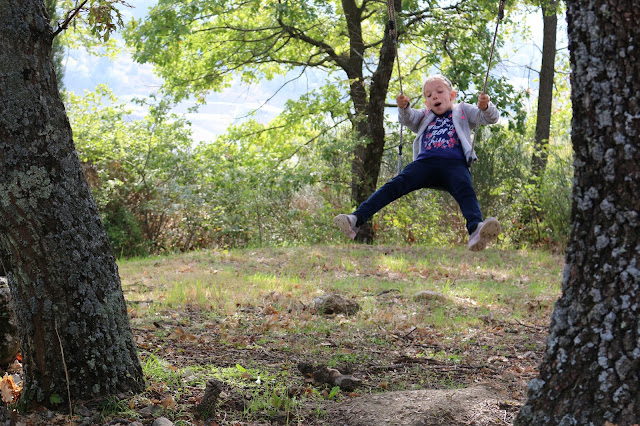





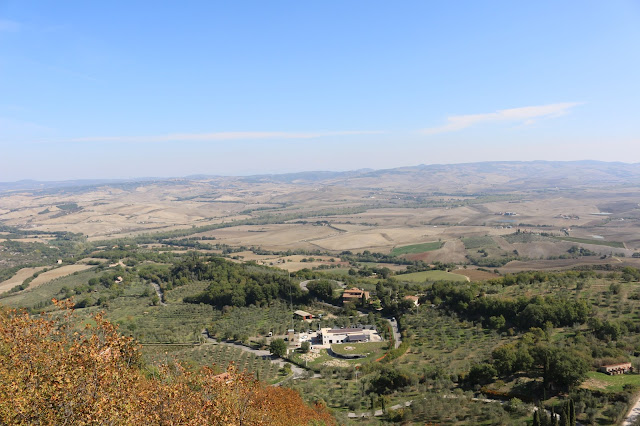






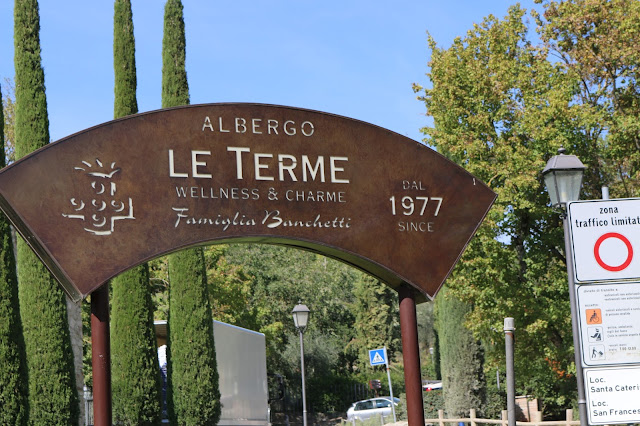




























































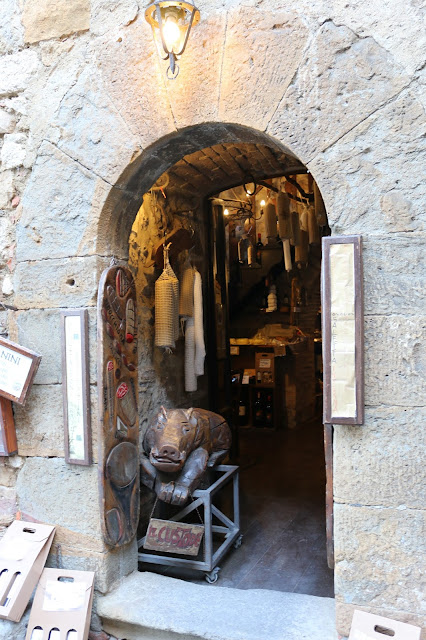











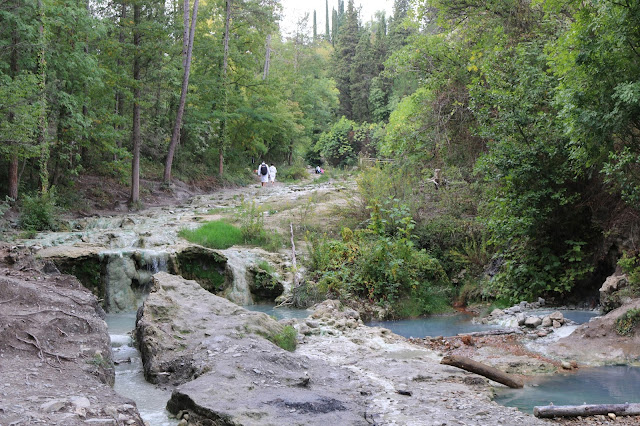




















Comments
Post a Comment